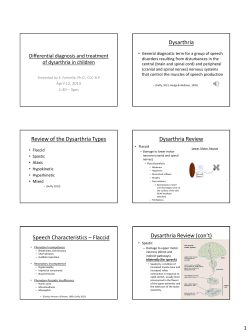
Document 66099
Childhood Dysarthria Kathleen Mikullitz & Kimme Norton What is Childhood Dysarthria? A group of motor speech disorders that affects the neuromuscular execution of speech Characterized by abnormalities in: CNS and/or PNS Neuromuscular features, including: strength, steadiness, tone, accuracy, and speed and range of movement Can affect ALL systems necessary for speech: Respiration, phonation, articulation, resonance, and prosody (van Mourik, Catsman-Berrevoets, Paquier, Yousef-Bak, & van Dongen, 1997; Duffy, 2005) Types and Symptoms Flaccid – Weakness Spastic – Rigidity Ataxic – Incoordination Hypokinetic – Rigidity; Problems with initiating movement Hyperkinetic – Involuntary movements Unilateral Upper Motor Neuron – Weakness; Incoordination Mixed – Variable (Duffy, 2005; Andrianopoulos, 2008) Childhood Dysarthria Congenital or Developmental: The neurologic insult takes place at birth or prior to the development of speech and language Acquired: The individual may have developed some speech and language skills prior to the neurologic insult (Caruso & Strand, 1999) Speech Characteristics Marked difficulties with strength, speech, and accuracy of articulatory movement. Weak vocal quality (lack of respiratory support) Hypo- or hypernasality Weak articulatory contacts Rapid or slow speaking rate Distortion of vowels that involve spreading intrinsic tongue muscles: /i/, /ai/, /ei/, and /ɔ ɪ/. Imprecise or weakly targeted consonants /r/, /l/, and /s/ Generally weak, mushy, garbled, imprecise speech (McCaffrey, 2008) Non-Speech Characteristics Difficulties with: Sucking Chewing Swallowing May cause: Drooling Gagging Choking (McCaffrey, 2008) Disorders/Syndromes Associated with Childhood Dysarthria Neurodevelopmental: Spina Bifida and Hydrocephalus Genetic: Fragile X syndrome Chromosomal: Down’s syndrome Sporadic: Prader-Willi syndrome Neurodevelopmental: Spina Bifida with Hydrocephalus (SBH) Spina Bifida: Incomplete fusion of the vertebral column Hydrocephalus: Excess of cerebrospinal fluid (CSF) in the brain Æ Enlarged skull SBH: Malformation of the cerebellum Ataxic dysarthria Three clusters of speech: Articulatory inaccuracy Prosodic excess Phonatory-prosodic insufficiency (Bhatnagar, 2002; Huber-Okrainec, Dennis, Brettschneider, & Spiegler, 2002) Genetic: Fragile X Syndrome Prevalence: 1:4,000 Cause: Mutation of FMR1 gene on the X chromosome Speech is characterized by: Dysarthria Dyspraxia Articulatory distortions and substitutions (Shprintzen, 2000; Turner, Webb, Wake, & Robinson, 1996, as cited in Roberts, Mirrett, Anderson, Burchinal, & Neebe, 2002) Chromosomal: Down’s Syndrome Prevalence: 1:1,000 Cause: A third 21st chromosome Æ Trisomy 21 Primary feature: Hypotonia Æ Dysarthria “Floppy” Speech is characterized by: Low pitch Hypernasality Breathiness Articulatory distortions Increased rate Reduced prosody (Jung, Gagne, Godden, Leeper, Moon, & Seewalk, 1989; Shprintzen, 2000) Sporadic: Prader-Willi Syndrome Prevalence: 1: 12,000-15,000 Cause: Deletion on chromosome 15q11 Long arm of the paternally derived chromosome Delayed motor development secondary to hypotonia Flaccid dysarthria Speech is characterized by: Hypernasality Reduced intelligibility Articulation errors (Stark, 2006; Prader-Willi Syndrome Association, 2008) Treatment Depends on type and severity of symptoms Children generally receive a better prognosis than adults due to neural plasticity Intervention is not a “one size fits all” solution Beneficial to the child What problem does it solve? Evidence based Grounded in theory? How much treatment is necessary? (Caruso & Strand, 1999; Yorkston & Beukelman, 2004) Severity-Based Treatment Level of severity and type of dysarthria influences the course and structure of intervention Remediation of mild to moderate dysarthria Compensatory strategies Remediation of severe dysarthria Alternative form of communication necessary (Caruso & Strand, 1999) Treatment May Target: Respiration: To obtain sufficient breath support for speech Phonation: To reduce excessive Breathiness Resonance: To reduce hypernasality Articulation: To coordinate and strengthen the articulators Prosody: To create phonetic contrasts in speech Loudness: Feedback, Visi-pitch, delayed auditory feedback (DAF) (Caruso & Strand, 1999) Treatment Ideas Promote the inclusion of: Family members and caregivers to increase generalization Alternative modes of communication Enhancement strategies (e.g., eye contact and facial expression) Repair strategies and self-monitoring Strategies to improve listener comprehension Support the development of: Phonological awareness and literacy Receptive and expressive language Self-esteem (Caruso & Strand, 1999) Future Research Childhood Dysarthria Prevalence: Currently unknown Masked by primary diagnosis Diagnosticians need to include assessment for dysarthria within the testing battery Intervention Identification of effective treatment methods Evidence-Based Practice References Andrianopoulos, M. V. (2008). Introduction to motor speech disorders. Retrieved January 22, 2008, from University of Massachusetts Amherst, Communication Disorders Website: http://www-unix.oit.umass.edu/~mva/pdf/ComDis_624_lecture_1A_08.pdf Bhatnagar, S. C. (2002). Neuroscience for the study of communicative disorders. (2nd ed.). Philadelphia, PA: Lippincott Williams & Wilkins. Caruso, A. J. & Strand, E. A. (1999). Clinical management of motor speech disorders in children. New York: Thieme Duffy, J. R. (2005) Motor speech disorders: Substrates, differential diagnosis, and management. St. Louis, MO: Elsevier Mosby. Huber-Okrainec, J., Dennis, M., Brettschneider, J. & Spiegler, B. J. (2002). Neuromotor speech deficits in children and adults with spina bifida and hydrocephalus. Brain and Language, 80(3), 592-602. Jung, J. H., Gagne, J. P., Godden, A. L., Leeper, H. A., Moon, J. B., & Seewald, R. C. (1989). Genetic syndromes in communication disorders. Austin, TX: PROED. McCaffrey, P. (2008). Neuropathologies of swallowing and speech. Retrieved April 29, 2008, from California State University, Chico, The Neuroscience on the Web Series: http://www.csuchico.edu/~pmccaffrey/syllabi/SPPA342/342unit14.html References – Continued… Prader-Will Syndrome Association. (2008, February 21). Basic facts about PWS: A diagnosis and reference guide for physicians and other health professionals. Retrieved April 29, 2008, from the World Wide Web: http://www.pwsausa.org/syndrome/basicfac.htm Roberts, J. E., Mirrett, P., Anderson, K., Burchinal, M., & Neebe, E. (2002). Early communication, symbolic behavior, and social profiles of young males with fragile X syndrome. American Journal of Speech-Language Pathology, 11, 295304. Shprintzen, R. J. (2000). Syndrome identification for speech-language pathology: An illustrated pocketguide. San Diego, CA: Singular. Stark, S. (2006). Neurodevelopmental disorders with genetic etiologies and speech and language disorders. van Mourik, M., Catsman-Berrevoets, C. E., Paquier, P. F., Yousef-Bak, E., & van Dongen, H. R. (1997). Acquired childhood dysarthria: Review of its clinical presentation. Pediatric Neurology, 17(4), 299-307. Yorkston, K. M., & Beukelman, D. R. (2004, May 11). Dysarthria: Tools for clinical decision-making. The ASHA Leader, pp. 4-5, 20-21.
© Copyright 2025





















